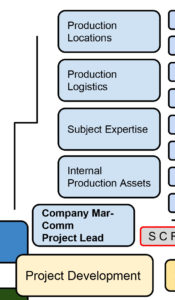The Keys To Successful Video Workflow
Post by Phenomenon, March 28, 2017
Successful Video Workflow
Take the wrinkles out of workflow on your next project and deliver greater results.
In our last blog post, I outlined six key questions clients should ask when seeking and vetting the services and staffs of video production companies. In that post, I encouraged clients to require “seamless” workflow practices from their production partners.
Successful Video Workflow. In this post, I present several keys to developing and executing great video productions using tested and proven video workflow practices. Successful video workflow factors can help determine if you the client and your project team will successfully iron out the potential wrinkles of your workflow experience and delivers excellent and measurable results.
Let’s start with workflow. What is workflow in the context of video production? Rather than telling you what it is, I’d like to show you what it is.
At Phenomenon, we’ve branded our workflow practices as FULL FLOW PRODUCTION bringing the full impact of our people, experience, tools and practices to bare on clients’ projects. We practice a documented and thus continually evolved workflow process; one that can easily be shared with you our client and consistently refined.
I use a proprietary info graphic to illustrate for my clients and our producers how successful video workflow moves through project development here at Phenomenon. Imagine the information in the below graphic is focused on you the client and your team. The information is charted from your perspective.
In this FULL FLOW PRODUCTION graphic, INTERNAL ASSETS (charted in the blue box on the far left of the graphic) drive the client path as we move through and tackle the tasks of workflow. All client tasks are identified in varying degrees of blue. Phenomenon and our producer tasks are identified in varying shades of green within the bottom path.
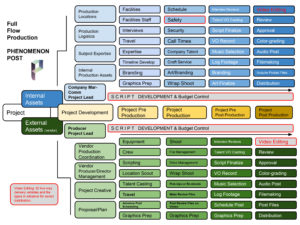
In this graphic, you can see in the beige-colored box representing PROJECT DEVELOPMENT and where you the client are represented in the light blue box as your company’s Project Lead. Your production company’s producer is identified in the light green box as Producer-Project Lead.
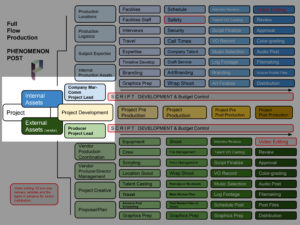
You can follow the entire scope of project workflow in this next graphic where you see project pre-production, project production, pre-post production and project post production in grades of yellow blocks. Notice how script development and budget management is happening throughout the workflow.
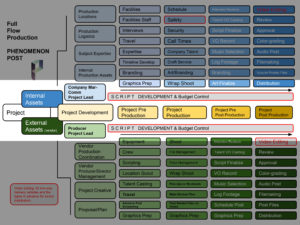
In this next graphic, I’ve highlighted the Project Pre-Production columns. Here’s where all the wrinkles of your project development must be ironed out to get a great start on the work. Planning is everything. In light blue is the client task set during this step of workflow. In light green is the production company/producer task list for this step of workflow duties. Each column including the first one, Project Development, shows us a set of tasks that move us through the work. Eventually we’re led to post production and fulfillment.
Here is a copy of the Full Flow Production Chart you can download for your reference.
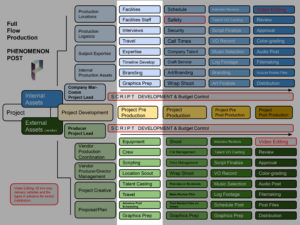
I’d like to take a minute to focus on the very first column of tasks for you the client and our producer/project lead at Phenomenon. You can see in the info graphic that I identify four tasks for the client and four tasks for the Phenomenon project lead. Each of these tasks have sub considerations, however, for the sake of creating a 10,000-foot view of Phenomenon’s workflow, I’ve limited the task list in early project development to four categories or work.
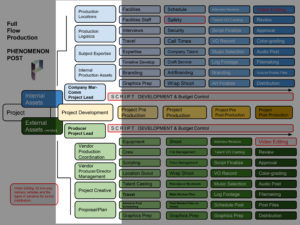
These early project tasks are crucial for giving successful video workflow a good start. You and your production company must achieve success with these foundation building blocks if you want to produce and deliver excellent video content.
Early into it. As the client, you’ve got a set of important questions to attack in early this early phase of production:
1. To craft a great video and cover all the visual narrative in our video, what production locations to we need to line up either at our company offices, in a studio or on location to tell the story?
2. Are there production logistics we need to consider? What is the lighting like in the plant? Can we get our company leadership to and from the location easily without compromising their busy schedules? Is the location safe? Do we need protective gear for talent, clients and crew? Where do we park vehicles belonging to the full production team? And a big question: where do we order lunch?
3. Subject Expertise. A huge question for you and your producer. Who within your company is going to provide expert narrative or guidance to you, the producer and even your director and video editor? The expert might be you. Who knows the subject matter inside and out? The expert might host the video on camera or be included in the vide with an interview or text quote. Sometimes, the expert may in fact be a team of people and all of them might be interviewed on or off-camera.
4. Finally. What type of Internal Assets might you need to schedule, acquire and manage for the production? Do you need company vehicles for the shoot? Do you need the assistance of company employees or management to play roles as leads or extras in the video? If you’re a restaurant, do you need to prep and stage recipes or dishes from your menu and who will prep the food? Will you staff artist need to produce or provide artwork, logos, graphics or technical charts to your production company for editing work?
Successful video workflow tasks assigned to your production company or their producer-lead are just as significant to assisting the full team in the workflow journey.
1. Every project has multiple moving parts and people. Project Coordination is an art and a science- the oil that lubricates the workflow engine and keeps the production running smoothly. A production coordinator is worth every penny of budget. The producer or producer-director is the conductor and often creative force who is also charged with coordinating every aspect of the production work.
2. Video production and those who produce video for clients often walk a fine line between wearing the hat of artist and that of the business person. Successful production management is rooted in good leadership. Video projects need a general who in every sense of being a professional is going to closely hold and manage not only your creative but your budget. Thus, making good creative and budget decisions are keys to successful workflow and great outcomes.
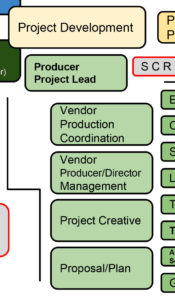
3. Who is responsible for getting the creative off the ground? Is there an ad agency involved who has developed creative for you and this particular video project? Did you and your company’s internal creative services team develop the creative? Or, do you need Phenomenon to play a role in conceiving the creative and story devices? Creative is probably a whole other blog as part of this discussion. For now it suffices to say that creative is your road map to engaging audiences and moving numbers; making sales, influencing your customers. Be sure, however, attention paid early on in the workflow to crafting smart, relevant and affordable creative is key to happy and productive workflow.
4. Finally. Is the proposal practical? Doe sit make sense on all fronts? Can it be executed with the allocated budget and within set timelines? With television production all the axioms apply. You can count on Murphy’s Law and the old saying that “the only thing that is certain is that nothing is certain.” Vet your plan. Trust your production experts and provide you and your crew enough assets to win.
Let’s close with slate of additional workflow-related questions related to successful video workflow you may want to chew on with your video production partner:
What reporting platform and practices will Production Company X use to communicate planning, progress, problems, metrics and outcomes?
Will Company X use platforms like BaseCamp, Go To Meeting, weekly conference calls or simple email as part of general workflow communication?
Who is responsible for handling (video) media after the shoot? Will you the client get to see the raw video and how will that video be delivered to you for review of the work? Is it your job to “log” or label the shots the crew captures in preparation for the editing?
Is the production lead expecting you to be at the edit session? If so, how much time should you allocate? Can you simply review rough cuts online?

Phenomenon facility images. Photo by Jason Cohn
What are your expectations for the review process on the client-side of the production? Will you be able to offer notes online, via an email, on a call, or in person? How long after client reviews should you expect revisions to be made?How will you review rough cuts of your video? Online? Via DVD? In the edit suite?
Once the video is approved, how will the program be delivered to you and ultimately your audience? Electronic files? DVD’s? What compression and codecs will be used to create your digital files? And, the big one, does anyone use video”tape” anymore? 🙂
If you have questions about how
successful video workflow can impact your next video project give Phenomenon a call. We’ll help you tell your story and take away the pain points of workflow.
Phenomenon is a commercial and corporate video production company that has served clients and their television projects since 2007. Our short-form ad work, documentary filmmaking and proven corporate production is led by a unique team of experienced content creatives. Our work is expressed in each new project through the talents and skills of our veteran team. We help our clients brand, market and deliver their products, people and practices to target audiences. We help our clients think and execute like mediamakers developing content and media that moves markets and minds. Our own brand comes alive in our work, our creative process and in the many successes our clients and their projects enjoy. We work hard to have our clients return to their stakeholders as heroes, with prized videos in hand and their stories communicated to a variety of audiences via multiple platforms.

